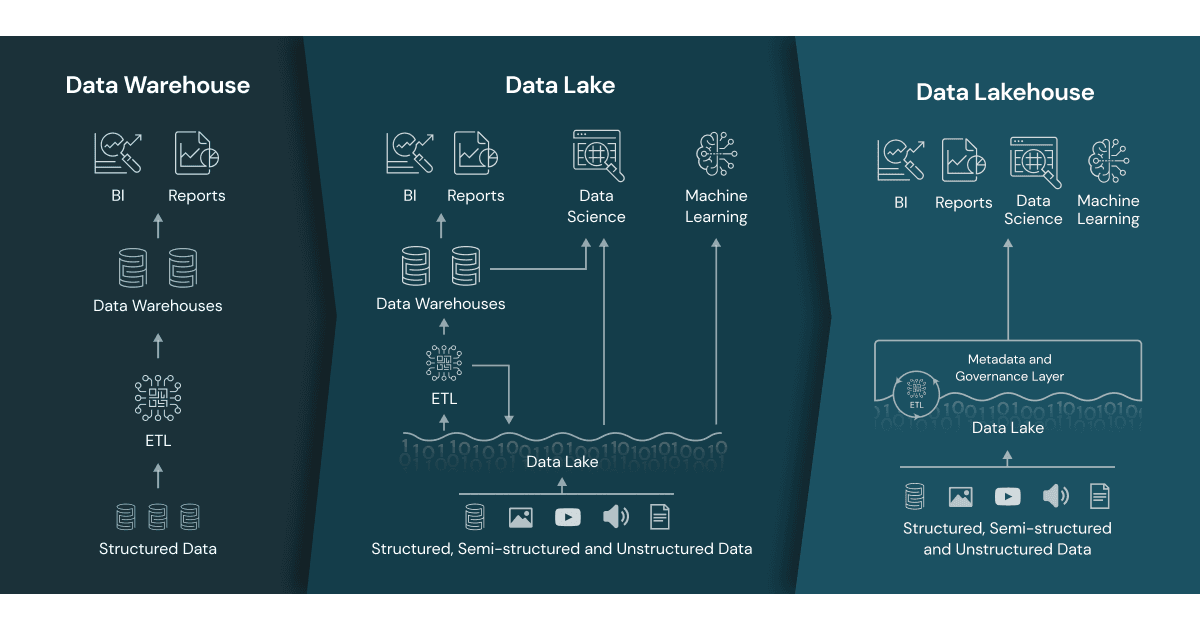The main challenge with a data lake architecture is that raw data is stored with no oversight of the contents. For a data lake to make data usable, it needs to have defined mechanisms to catalog, and secure data. Without these elements, data cannot be found, or trusted resulting in a “data swamp." Meeting the needs of wider audiences require data lakes to have governance, semantic consistency, and access controls.
What

A data lake is a centralized repository that allows you to store all your structured and unstructured data at any scale. You can store your data as-is, without first having to structure the data, and run different kinds of analytics - from the dashboards and visualizations to big data processing, real-time analytics, and machine learning in order to guide better decisions
Why do you need a Data Lake
Organizations that successfully generate business value from their data, will outperform their peers. Ability to do new types of analytics like machine learning over new sources like log files, data from click-streams, social media, and internet connected devices stored in the data lake. Ability to identify, and act upon opportunities for business growth faster by attracting and retaining customers, boosting productivity, proactively maintaining devices, and making informed decisions.
Data Lake Vs Data Warehouse
A data warehouse is a database optimized to analyze relational data coming from transactional systems and line of business applications. The data structure, and schema are defined in advance to optimize for fast SQL queries, where the results are typically used for operational reporting and analysis. Data is cleaned, enriched, and transformed so it can act as the “single source of truth” that users can trust.
A data lake is different, because it stores relational data from line of business applications, and non-relational data from mobile apps, IoT devices, and social media. The structure of the data or schema is not defined when data is captured. This means you can store all of your data without careful design or the need to know what questions you might need answers for in the future. Different types of analytics on your data like SQL queries, big data analytics, full text search, real-time analytics, and machine learning can be used to uncover insights.

Elements of a Data Lake and Analytics Solution
- Data Movement - Data Lakes allow you to import any amount of data that can come in real-time. Data is collected from multiple sources, and moved into the data lake in its original format. This process allows you to scale to data of any size, while saving time of defining data structures, schema, and transformations.
- Analytics - Data Lakes allow various roles in your organization like data scientists, data developers, and business analysts to access data with their choice of analytic tools and frameworks. This includes open source frameworks such as Apache Hadoop, Presto, and Apache Spark, and commercial offerings from data warehouse and business intelligence vendors. Data Lakes allow you to run analytics without the need to move your data to a separate analytics system.
- Securely store and catalog data - Data Lakes allow you to store relational data like operational databases and data from line of business applications, and non-relational data like mobile apps, IoT devices, and social media. They also give you the ability to understand what data is in the lake through crawling, cataloging, and indexing of data. Finally, data must be secured to ensure your data assets are protected.
- Machine Learning - Data Lakes will allow organizations to generate different types of insights including reporting on historical data, and doing machine learning where models are built to forecast likely outcomes, and suggest a range of prescribed actions to achieve the optimal result.
Value of a Data Lake
The ability to harness more data, from more sources, in less time, and empowering users to collaborate and analyze data in different ways leads to better, faster decision making. Examples where Data Lakes have added value include:
- Improved customer interactions - A Data Lake can combine customer data from a CRM platform with social media analytics, a marketing platform that includes buying history, and incident tickets to empower the business to understand the most profitable customer cohort, the cause of customer churn, and the promotions or rewards that will increase loyalty.
- Improved R & D Innovation choices - A data lake can help your R&D teams test their hypothesis, refine assumptions, and assess results—such as choosing the right materials in your product design resulting in faster performance, doing genomic research leading to more effective medication, or understanding the willingness of customers to pay for different attributes.
- Improved operational efficiencies - The Internet of Things (IoT) introduces more ways to collect data on processes like manufacturing, with real-time data coming from internet connected devices. A data lake makes it easy to store, and run analytics on machine-generated IoT data to discover ways to reduce operational costs, and increase quality.
Practical Implementations
- Students enrolling for any AI related course from Carnegie Training Institute have access to practical and working implementation guidelines
Sources
- AWS Reference Page


